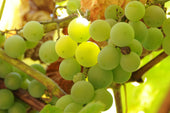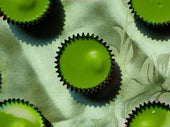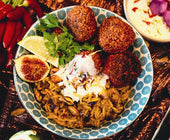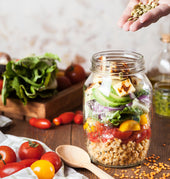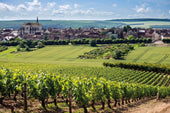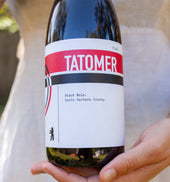
Wine Travel: Portugal and Vinho Verde
[caption id="attachment_2654" align="aligncenter" width="584"] Vinho Verde: Rows of Loureiro Grapes in October[/caption]Portugal is famous for its Port wine history, however the region just north of Porto and Douro River is a thriving area called Vinho Verde. Vinho Verde is the second-highest selling wine in Portugal. The region was demarcated in 1908 and is considered to be one of the oldest regions in Portugal and one of the largest in Europe. It spans from the Douro to the Minho River near Spain. To the north there is the Minho River, the south is the Douro River, and the Freita, Arada and Montemuro mountain ranges. To the east there is the Peneda, Geres, Cabriera and Marao mountain ranges and Atlantic Ocean to the west.[caption id="attachment_2655" align="aligncenter" width="467"]
Vinho Verde: Rows of Loureiro Grapes in October[/caption]Portugal is famous for its Port wine history, however the region just north of Porto and Douro River is a thriving area called Vinho Verde. Vinho Verde is the second-highest selling wine in Portugal. The region was demarcated in 1908 and is considered to be one of the oldest regions in Portugal and one of the largest in Europe. It spans from the Douro to the Minho River near Spain. To the north there is the Minho River, the south is the Douro River, and the Freita, Arada and Montemuro mountain ranges. To the east there is the Peneda, Geres, Cabriera and Marao mountain ranges and Atlantic Ocean to the west.[caption id="attachment_2655" align="aligncenter" width="467"] Traditional Vine Training[/caption]Gentle hills, river valleys, small tributaries and granite soils contribute to the unique flavors of Vinho Verde. The region's climate is heavily influenced by the high rainfall (1200mm average per year compared to 700mm in Napa). The temperature changes in line with the precipitation, but it is not extreme but rather mild. Due to the high rainfall, traditional wine growers used to train the vines high off the ground on trees, canopies or pergolas. However, modern vine training systems and new technology have helped wine growers train the vines on lower trellis, allowing for better ripeness of grapes and to improve production conditions.There are 9 sub-regions in Vinho Verde, each with its specific micro-climate, wine type and vine training methods. Closer to the Atlantic, regions like Ave, Cavado and Lima are well known for their Loureiro and Arinto grape due to the low altitude, ocean influence. Monacao and Melgaco is famous for the Alvarinho grape due to their micro-climate consisting of cold winters with high rainfall and hot dry summers. Baiao region is very unique due to its proximity to the Dour Demarcated Region. It is very inland and the soil is mostly clay instead of granite. The inland temperature allows for colder, drier winters and hotter, drier summers. These conditions allow grape varieties with a longer ripening time. Better for Azal, Avesso to reach full maturity.We may know Vinho Verde as the light white wine that has a little bit of sparkle and served quite chilled. However there are a number of different types of wines made: White, Rose, Red and Sparkling. The main grape varieties for White wine are: Alvarinho, Arinto, Avesso, Azal, Loureiro and Trajadura. The classic White Vinho Verde has high acidity, low alcohol and a tiny bit of spritz (depending on the style). Low alcohol also means there will be some residual sugar in the wine. However the residual sugar is counter balanced by the high acidity from the grapes. Most traditional Vinho Verde white wine producers will not allow maloactic fermentation to be completed in order to preserve the primary aromas and the crisp finish.Small quantities of Red Vinho Verde are produced and rarely exported out of Portugal. The main grape varieties for Red wine are: Amaral, Borracal, Alvarelhao, Espadiero, Padeiro, Pedral, Rabo de Anho and Vinhao. The reds are refreshing with low tannins and medium bodied, served chilled to complement the foods of this region.
Traditional Vine Training[/caption]Gentle hills, river valleys, small tributaries and granite soils contribute to the unique flavors of Vinho Verde. The region's climate is heavily influenced by the high rainfall (1200mm average per year compared to 700mm in Napa). The temperature changes in line with the precipitation, but it is not extreme but rather mild. Due to the high rainfall, traditional wine growers used to train the vines high off the ground on trees, canopies or pergolas. However, modern vine training systems and new technology have helped wine growers train the vines on lower trellis, allowing for better ripeness of grapes and to improve production conditions.There are 9 sub-regions in Vinho Verde, each with its specific micro-climate, wine type and vine training methods. Closer to the Atlantic, regions like Ave, Cavado and Lima are well known for their Loureiro and Arinto grape due to the low altitude, ocean influence. Monacao and Melgaco is famous for the Alvarinho grape due to their micro-climate consisting of cold winters with high rainfall and hot dry summers. Baiao region is very unique due to its proximity to the Dour Demarcated Region. It is very inland and the soil is mostly clay instead of granite. The inland temperature allows for colder, drier winters and hotter, drier summers. These conditions allow grape varieties with a longer ripening time. Better for Azal, Avesso to reach full maturity.We may know Vinho Verde as the light white wine that has a little bit of sparkle and served quite chilled. However there are a number of different types of wines made: White, Rose, Red and Sparkling. The main grape varieties for White wine are: Alvarinho, Arinto, Avesso, Azal, Loureiro and Trajadura. The classic White Vinho Verde has high acidity, low alcohol and a tiny bit of spritz (depending on the style). Low alcohol also means there will be some residual sugar in the wine. However the residual sugar is counter balanced by the high acidity from the grapes. Most traditional Vinho Verde white wine producers will not allow maloactic fermentation to be completed in order to preserve the primary aromas and the crisp finish.Small quantities of Red Vinho Verde are produced and rarely exported out of Portugal. The main grape varieties for Red wine are: Amaral, Borracal, Alvarelhao, Espadiero, Padeiro, Pedral, Rabo de Anho and Vinhao. The reds are refreshing with low tannins and medium bodied, served chilled to complement the foods of this region.
 Vinho Verde: Rows of Loureiro Grapes in October[/caption]Portugal is famous for its Port wine history, however the region just north of Porto and Douro River is a thriving area called Vinho Verde. Vinho Verde is the second-highest selling wine in Portugal. The region was demarcated in 1908 and is considered to be one of the oldest regions in Portugal and one of the largest in Europe. It spans from the Douro to the Minho River near Spain. To the north there is the Minho River, the south is the Douro River, and the Freita, Arada and Montemuro mountain ranges. To the east there is the Peneda, Geres, Cabriera and Marao mountain ranges and Atlantic Ocean to the west.[caption id="attachment_2655" align="aligncenter" width="467"]
Vinho Verde: Rows of Loureiro Grapes in October[/caption]Portugal is famous for its Port wine history, however the region just north of Porto and Douro River is a thriving area called Vinho Verde. Vinho Verde is the second-highest selling wine in Portugal. The region was demarcated in 1908 and is considered to be one of the oldest regions in Portugal and one of the largest in Europe. It spans from the Douro to the Minho River near Spain. To the north there is the Minho River, the south is the Douro River, and the Freita, Arada and Montemuro mountain ranges. To the east there is the Peneda, Geres, Cabriera and Marao mountain ranges and Atlantic Ocean to the west.[caption id="attachment_2655" align="aligncenter" width="467"] Traditional Vine Training[/caption]Gentle hills, river valleys, small tributaries and granite soils contribute to the unique flavors of Vinho Verde. The region's climate is heavily influenced by the high rainfall (1200mm average per year compared to 700mm in Napa). The temperature changes in line with the precipitation, but it is not extreme but rather mild. Due to the high rainfall, traditional wine growers used to train the vines high off the ground on trees, canopies or pergolas. However, modern vine training systems and new technology have helped wine growers train the vines on lower trellis, allowing for better ripeness of grapes and to improve production conditions.There are 9 sub-regions in Vinho Verde, each with its specific micro-climate, wine type and vine training methods. Closer to the Atlantic, regions like Ave, Cavado and Lima are well known for their Loureiro and Arinto grape due to the low altitude, ocean influence. Monacao and Melgaco is famous for the Alvarinho grape due to their micro-climate consisting of cold winters with high rainfall and hot dry summers. Baiao region is very unique due to its proximity to the Dour Demarcated Region. It is very inland and the soil is mostly clay instead of granite. The inland temperature allows for colder, drier winters and hotter, drier summers. These conditions allow grape varieties with a longer ripening time. Better for Azal, Avesso to reach full maturity.We may know Vinho Verde as the light white wine that has a little bit of sparkle and served quite chilled. However there are a number of different types of wines made: White, Rose, Red and Sparkling. The main grape varieties for White wine are: Alvarinho, Arinto, Avesso, Azal, Loureiro and Trajadura. The classic White Vinho Verde has high acidity, low alcohol and a tiny bit of spritz (depending on the style). Low alcohol also means there will be some residual sugar in the wine. However the residual sugar is counter balanced by the high acidity from the grapes. Most traditional Vinho Verde white wine producers will not allow maloactic fermentation to be completed in order to preserve the primary aromas and the crisp finish.Small quantities of Red Vinho Verde are produced and rarely exported out of Portugal. The main grape varieties for Red wine are: Amaral, Borracal, Alvarelhao, Espadiero, Padeiro, Pedral, Rabo de Anho and Vinhao. The reds are refreshing with low tannins and medium bodied, served chilled to complement the foods of this region.
Traditional Vine Training[/caption]Gentle hills, river valleys, small tributaries and granite soils contribute to the unique flavors of Vinho Verde. The region's climate is heavily influenced by the high rainfall (1200mm average per year compared to 700mm in Napa). The temperature changes in line with the precipitation, but it is not extreme but rather mild. Due to the high rainfall, traditional wine growers used to train the vines high off the ground on trees, canopies or pergolas. However, modern vine training systems and new technology have helped wine growers train the vines on lower trellis, allowing for better ripeness of grapes and to improve production conditions.There are 9 sub-regions in Vinho Verde, each with its specific micro-climate, wine type and vine training methods. Closer to the Atlantic, regions like Ave, Cavado and Lima are well known for their Loureiro and Arinto grape due to the low altitude, ocean influence. Monacao and Melgaco is famous for the Alvarinho grape due to their micro-climate consisting of cold winters with high rainfall and hot dry summers. Baiao region is very unique due to its proximity to the Dour Demarcated Region. It is very inland and the soil is mostly clay instead of granite. The inland temperature allows for colder, drier winters and hotter, drier summers. These conditions allow grape varieties with a longer ripening time. Better for Azal, Avesso to reach full maturity.We may know Vinho Verde as the light white wine that has a little bit of sparkle and served quite chilled. However there are a number of different types of wines made: White, Rose, Red and Sparkling. The main grape varieties for White wine are: Alvarinho, Arinto, Avesso, Azal, Loureiro and Trajadura. The classic White Vinho Verde has high acidity, low alcohol and a tiny bit of spritz (depending on the style). Low alcohol also means there will be some residual sugar in the wine. However the residual sugar is counter balanced by the high acidity from the grapes. Most traditional Vinho Verde white wine producers will not allow maloactic fermentation to be completed in order to preserve the primary aromas and the crisp finish.Small quantities of Red Vinho Verde are produced and rarely exported out of Portugal. The main grape varieties for Red wine are: Amaral, Borracal, Alvarelhao, Espadiero, Padeiro, Pedral, Rabo de Anho and Vinhao. The reds are refreshing with low tannins and medium bodied, served chilled to complement the foods of this region.

Another amazing find is the Sparkling wines produced from both Red and White grapes. The Sparkling Vinho Verde have great aromas with a lemon and light crisp finish. The Sparkling wines are produced the Champagne way, the same as Cava and Cremant. These Sparkling wines are good for fried cod fish and suckling pig.Next time you pick up a bottle of Vinho Verde, check the back label for the Seal of Guarantee. Vinho Verde is a gastronomic wine, thanks to its level of acidity and lightness, therefore experiment with different styles of food ranging from sushi, Thai to French cuisines.
 Contributed by Monica Yu , Assistant Wine Buyer for Plume Ridge Bottle
Contributed by Monica Yu , Assistant Wine Buyer for Plume Ridge Bottle








